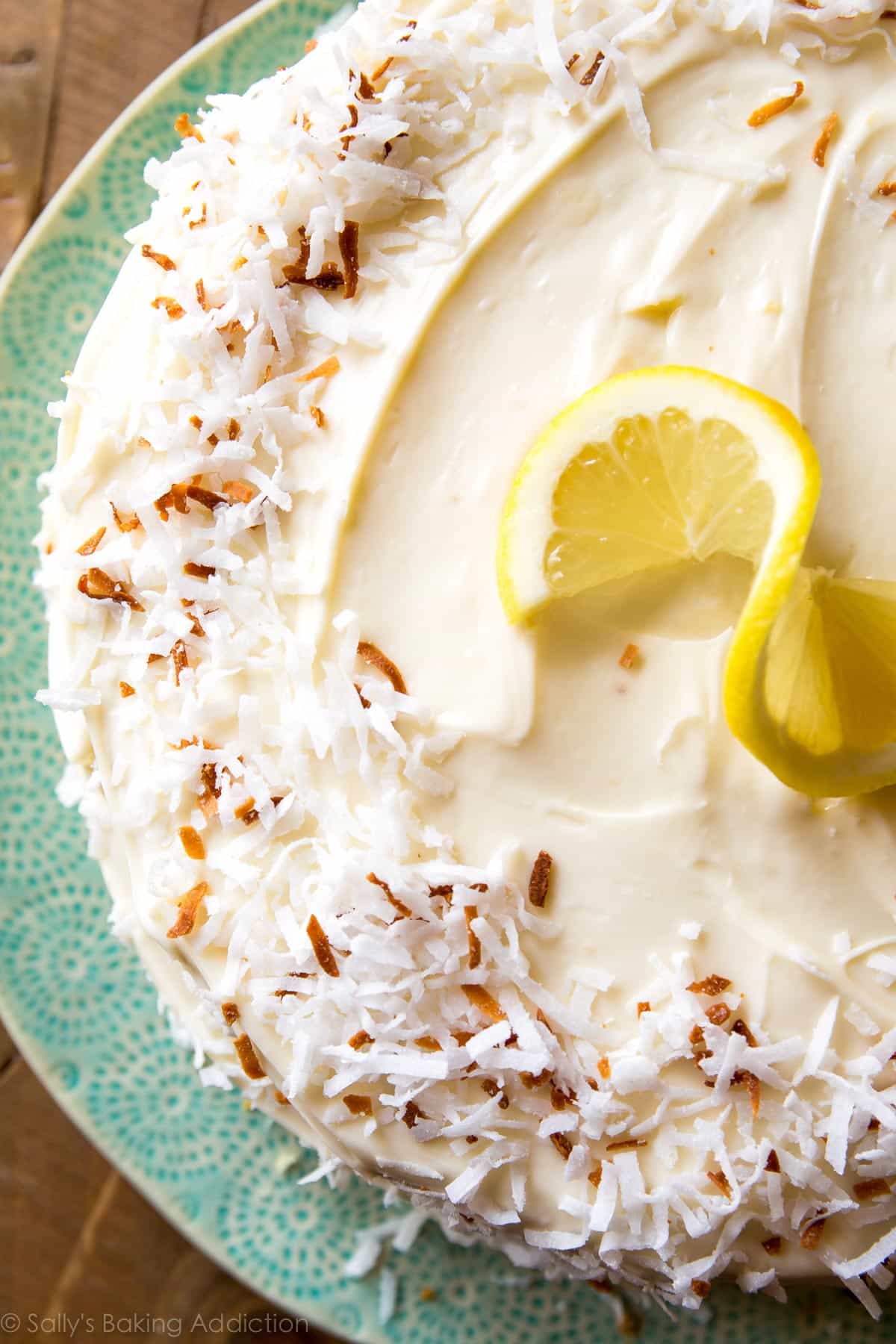
Introduction: Discover the Irresistible Combination of Lemon and Coconut
Are you a fan of tropical desserts? If so, get ready to discover the irresistible combination of lemon and coconut. In this section, we will explore the delightful flavors that come together in a lemon coconut cake. This citrus-flavored cake is a perfect balance of tangy lemon and creamy coconut, creating a dessert that is both refreshing and indulgent.
Whether you’re planning a special occasion or simply craving a sweet treat, this coconut cake recipe will surely satisfy your taste buds. We’ll delve into the ingredients and step-by-step instructions to help you create this delectable dessert in your own kitchen.
So, prepare yourself for a culinary adventure as we dive into the world of lemon and coconut, uncovering the secrets behind this mouthwatering tropical delight. Get ready to impress your friends and family with a homemade lemon coconut cake that will leave them wanting more.
Ingredients for a Mouthwatering Lemon Coconut Cake
To create a mouthwatering lemon coconut cake, you will need a combination of key ingredients that work together to produce a delightful and flavorful dessert.
First and foremost, the star of the show is lemon zest and lemon juice. These citrus elements provide a tangy and refreshing taste that complements the sweetness of the cake. The zest adds aromatic notes while the juice contributes both flavor and acidity.
Additionally, shredded coconut plays a crucial role in adding texture and enhancing the coconut flavor in every bite. It provides a tropical twist to the overall taste experience.
Butter and sugar are essential components for creating moistness and sweetness in the cake. They help to achieve a tender crumb texture, while also adding richness to each slice.
Flour is another fundamental ingredient that provides structure to the cake. It acts as a binding agent, holding all other ingredients together.
Eggs are crucial for their binding properties as well. They add moisture, richness, and contribute to achieving an airy texture when beaten properly.
Lastly, baking powder is necessary for leavening purposes. It helps the cake rise during baking by creating air bubbles within the batter.
By combining these carefully selected ingredients in proper proportions, you can create an irresistible lemon coconut cake that will leave your taste buds craving for more.
Preparation:
Mixing the dry ingredients – flour and baking powder.
Creaming the butter and sugar together until light and fluffy.
Incorporating the eggs one at a time.
Addition of lemon zest and juice for that tangy flavor.
Folding in shredded coconut to infuse tropical taste.
Baking the batter in a preheated oven until golden brown.
In the preparation stage of baking, one crucial step is mixing the dry ingredients. This step ensures that the ingredients are evenly distributed throughout the batter, resulting in a well-balanced and consistent final product. When it comes to mixing dry ingredients, two common components are flour and baking powder.
Flour is a staple ingredient in baking and serves as the base for many recipes. It provides structure to baked goods by forming gluten when combined with liquid ingredients. Gluten gives dough elasticity and helps trap air bubbles during the baking process, resulting in a light and fluffy texture.
Baking powder, on the other hand, is a leavening agent that helps baked goods rise. It consists of an acid (usually cream of tartar) and a base (typically baking soda). When mixed with moisture and heat in the oven, baking powder releases carbon dioxide gas, causing dough or batter to expand. This creates a light and airy texture in cakes, muffins, and other baked treats.
To mix these dry ingredients properly, start by sifting or whisking them together in a bowl. This process not only combines them but also helps remove any lumps or clumps that may have formed during storage. The goal is to achieve an even distribution of flour and baking powder throughout the mixture so that every bite of your baked goods has consistent flavor and texture.
Remember to follow recipe instructions carefully regarding measurements for both flour and baking powder. Too much or too little can affect the final outcome of your baked goods.
In conclusion, mixing dry ingredients such as flour and baking powder is a crucial step in preparing for successful baking results. By ensuring proper distribution of these key components through sifting or whisking, you can create delicious treats with consistent texture and flavor every time.
Frosting Options to Enhance Your Lemon Coconut Cake Experience
When it comes to enhancing the taste and presentation of your lemon coconut cake, choosing the right frosting can make all the difference. In this section, we will explore three delicious frosting options that are sure to elevate your cake experience: cream cheese frosting, lemon glaze frosting, and coconut buttercream frosting.
Cream cheese frosting is a classic choice that pairs perfectly with the tangy flavors of lemon and coconut. Its smooth and creamy texture adds a luxurious touch to your cake. The subtle tanginess of cream cheese complements the sweetness of the cake, creating a delightful balance of flavors.
If you’re looking for a lighter and more refreshing option, lemon glaze frosting is an excellent choice. Made with fresh lemon juice and powdered sugar, this zesty glaze adds a burst of citrus flavor to your cake. It creates a glossy finish on top while infusing each bite with a tangy sweetness.
For those who love the tropical taste of coconut, coconut buttercream frosting is an irresistible option. Made with coconut milk or cream and butter, this rich and creamy frosting delivers a luscious coconut flavor that pairs beautifully with the lemony notes in your cake. It can be adorned with shredded coconut for added texture and visual appeal.
Whether you prefer the richness of cream cheese frosting, the zingy freshness of lemon glaze icing or the tropical decadence of coconut buttercream, these frostings offer different ways to enhance your lemon coconut cake experience. Experimenting with these options will allow you to find your perfect combination of flavors for a truly memorable dessert.
Tips for Decorating Your Lemon Coconut Cake with Style
When it comes to decorating your lemon coconut cake, there are a few tips that can help you add style and visual appeal to your dessert. Two popular options for enhancing the appearance of your cake are using candied lemon slices as a garnish and adding toasted coconut flakes on top.
Candied lemon slices make for a beautiful and vibrant decoration. To create these, thinly slice lemons and simmer them in a simple syrup until they become translucent. Once cooled, you can arrange them in an attractive pattern on top of your cake or around the edges. The candied lemon slices not only add visual interest but also provide a burst of sweet citrus flavor with each bite.
Toasted coconut flakes offer both texture and flavor to your cake. Before using them as a topping, spread the flakes evenly on a baking sheet and toast them in the oven until they turn golden brown. Sprinkle the toasted coconut flakes over the frosting or around the edges of the cake for an appealing crunch and tropical touch.
By incorporating these decorative elements into your lemon coconut cake, you can elevate its presentation from ordinary to extraordinary. These simple yet effective tips will surely impress your guests and make your dessert visually stunning.
Serving Suggestions for Your Heavenly Lemon Coconut Cake
When it comes to serving your heavenly lemon coconut cake, there are a few delicious options that can complement its flavors perfectly. One suggestion is to serve it with a tropical fruit salad on the side. This combination of tangy lemon and sweet coconut will be enhanced by the juicy and refreshing tropical fruits, creating a delightful balance of flavors.
Another option to consider is adding a scoop of creamy vanilla ice cream alongside your lemon coconut cake. The coolness and smoothness of the ice cream will provide a delightful contrast to the zesty flavors of the cake, creating a truly indulgent dessert experience.
Whether you choose to serve your lemon coconut cake with a tropical fruit salad or a scoop of vanilla ice cream, both options are sure to elevate the taste and enjoyment of this already heavenly treat. So go ahead and get creative with your serving suggestions, and let your guests savor every bite!
Conclusion: Indulge in the Tropical Bliss of Lemon Coconut Cake Today!
In conclusion, indulging in the tropical bliss of a lemon coconut cake is a delightful experience that shouldn’t be missed. The combination of zesty lemon and creamy coconut creates a flavor profile that transports you to a sunny beach paradise.
Whether you’re hosting a summer gathering, celebrating a special occasion, or simply treating yourself to something sweet, a lemon coconut cake is the perfect choice. Its refreshing taste and tropical aroma are sure to leave your taste buds satisfied.
So why wait? Treat yourself and your loved ones to the tantalizing flavors of a lemon coconut cake today. Whether you bake it from scratch or find it at your favorite bakery, this delectable dessert is guaranteed to bring joy and happiness with every bite. So go ahead, indulge in the tropical bliss of a lemon coconut cake and let your taste buds take you on an unforgettable journey.







